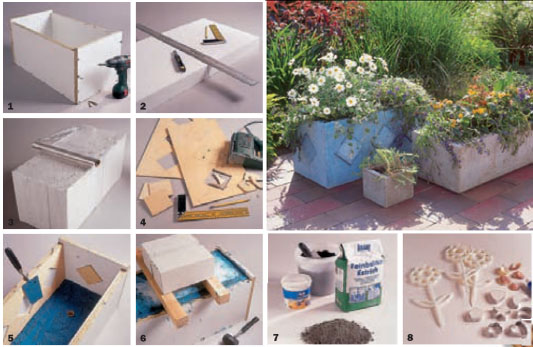 Rough or fine: It's all in the mix
Rough or fine: It's all in the mix
How fine or coarse the surface is, depends on the grit of the sand, contained in the respective mixture. Fine concrete screed, that we used here, together with a formwork made of coated panels, creates a smooth and slightly shiny surface. Screed cement contains coarser sand and results in a rougher surface.
To achieve an even coarser structure, you can cement, Sand and peat in relation 2: 3: 4 Mix; the material is as durable and long-lasting as concrete, but easier to edit. After two days of drying, corners can be rounded off with a wire brush and surfaces can be roughened. Spread with buttermilk, Mosses and lichens quickly settle on it and create a patina.
1 Die Schalplatten werden verschraubt,to be able to take them off easily. Coated chipboard is ideal: Concrete does not stick.
2 Für die innere Schalung Styroporplatten zu einem Block verkleben.
3 Folie garantiert, that the block can be easily detached later.
4 Für erhabene Muster Sperrholz für die langen Seiten mit Ausschnitten versehen und einsetzen.
5 Negativformen an die kurzen Seiten kleben. Insert corks for the water drainage holes, Insert reinforcement grid, pour thick concrete into the mold.
6 Styroporkern einsetzen und den Rest Beton einfüllen. Repeatedly compact/tamp, to minimize air pockets.
7 Leichter und durchlässiger ist Torfbeton.
8 Mit Keksformen gegossene Betonteile, Plastic flowers and the like can be glued to the box for decoration.
WHEN CONCRETE SHOULD SHOW COLOUR.
The concentrates are actually intended for tinting wall paints. To color concrete with it, dissolve them in water, so that the liquid is relatively thin. When mixing the ready mix, it replaces part of the water. You should keep this in mind when dosing the concentrate, that the color tone becomes considerably lighter as the concrete dries. If you are not sure, make test stones (see previous page) for which you write down the exact mixing ratio. There are no changes, if you subsequently paint the container with weather protection paint.
Decorative strips on the inside of the shuttering boards emboss patterns in the bucket walls. Raised decorations can be attached with concrete adhesive.
CONCRETE
Consists of cement, aggregate and water, those in relation 2:6:1 be touched. Aggregate is usually sand or gravel, but it can also fibers, Expanded clay or peat can be used, to make the mass more cohesive or to reduce the weight. REINFORCEMENT Thin mild steel wires, lying horizontally in the walls like rings, or wire mesh should be poured into the walls of the bucket. As with the large concrete structures (Houses, bridges etc.) they serve to stabilize the relatively brittle material, ensure a certain elasticity and reduce the tendency to tear. REPAIRS Chipped edges, Holes or cracks can be repaired with repair mortar.
WATER DEDUCTION
All planters must be guaranteed, that irrigation water can drain off easily. Therefore, the floor must be provided with drainage holes, which is a distance of about 20 cm apart. They can also be at floor level in the side walls.